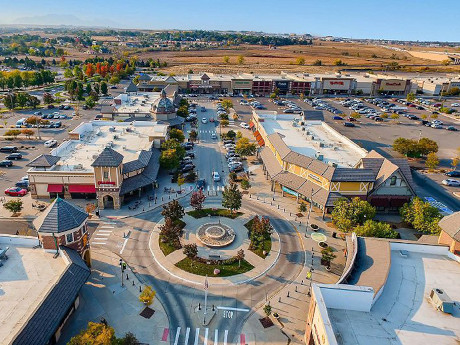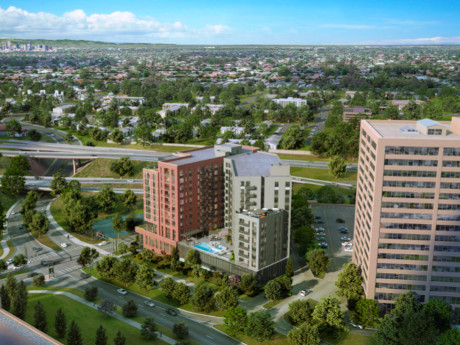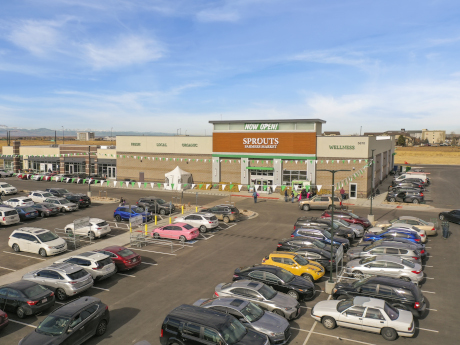— By Tami Lord, Senior Vice President, SRS Real Estate Partners — No longer the Cowtown of ages past, Denver has developed into an economically diverse, midsized city as demonstrated by both the residential and business growth over the last decade. Major companies now include Denver on their target list for potential headquarters, regional hubs, and distribution locations. Compared to the coastal markets, Denver is more affordable and offers a very desirable quality of life for employees, helping to put Denver on the short list. The pandemic only increased Denver’s growth trajectory. All of a sudden, people were able to maintain their current employment while living in a setting known for over 300 days of sun annually with easy access to hiking, skiing, biking, camping…the list goes on. The population growth has spurred rising housing and land prices. Coupled with rising construction costs, increasing real estate taxes, long permitting times and a tight employment market, traditional retail development has slowed. The lack of significant new development has pushed retail vacancy to a near-record low of 4.1 percent across the metro, according to data from CoStar. Many downtown retail markets across the country have been hit with higher vacancy rates in …
Market Reports
Like many communities across the West, affordable housing is a top issue in Denver. Monthly rent in Denver is now around $2,005, according to Zillow’s June 2022 data. This is up 20.4 percent since June 2019. The city is trying to do something about the lack of affordability. It approved the Expanding Housing Affordability Policy (EHA) this June, which overhauled Denver’s affordable housing requirements for new development. EHA was allowed after the 2021 passage of a Colorado statute, HB21-1117, which overturned a Colorado Supreme Court case commonly known as the Telluride decision. HB21-1117 expanded the ability of local Colorado governments to require inclusion of income-restricted units within new rental housing — something that had previously been prohibited in Colorado. While Denver has led within the state with EHA, other municipalities in Colorado, such as Littleton and Aspen, are beginning to consider new affordable housing policies in response to HB21-1117. In Denver, EHA primarily affects multifamily projects of 10 or more units. Those projects must proceed under EHA unless they submitted a concept site plan by June 30, 2022, and achieve final site development plan approval by Aug. 30, 2023. Non-residential projects and residential projects of nine or fewer units may …
By David Gagliano, Senior Vice President and Principal, Fuller Real Estate Leasing trends in the metro Denver office market are continuing their slow progression downward. Inquiries from tenants looking to lease office product is down 10 percent from 2021. Concurrently, we have seen an uptick in smaller office users who are looking for space in lieu of their home office. Landlords have been quick to concede to tenants, incentivizing them with extensive quantifiable tenant improvements and lease rates lower than their competition. Anecdotally, it becomes obvious with nearly every prospective tenant that they are viewing multiple properties. Not only are they viewing several properties, but many have several options within the exact vicinity of the subject property. This trend makes it even more critical for landlords to have the best representation from their brokers. This market instability also speaks to the favor landlords are giving to current tenants upon lease renewal, as capturing occupancy prior to vacating becomes vital. With current and most likely future increases in interest rates, we will see a dip in activity in owner-user purchases that should lead to a rise in leasing activity. The suburban markets are still seeing a surge in migration from the downtown …
Population, Absorption, New Construction Offer Opportunities in the Denver Multifamily Market
by Jeff Shaw
By Chris Mitton, Advisor, Pinnacle Real Estate Advisors Denver has been seeing major growth of new residents from 2020 through the second quarter of 2022. Denver is gaining many residents from coastal cities due to our lower cost of living, and gains of such tech giants as Conga, RingCentral, Xactly, Slack, and Angi. Since 2020, Denver has added 8,100 jobs in business services and 2,900 jobs in the financial activities sector. Over the last five years population growth in Denver has increased 8 percent compared to the 3.8 percent national average. The multifamily market has benefited from this population growth. Denver has absorbed 6,400 units over the past 12 months, placing it in the top 15 metro areas in the country. Colorado has seen record high prices in single family homes as well, which is pricing out many first-time homebuyers. This is forcing many renters to stay in multifamily apartments. However, if you haven’t been living under a rock, you know that the Federal Reserve has been increasing interest rates at a record pace. The single-family market has seen an increase from 1,200 homes for sale during the start of the year to 7,300 homes in August. With this increase in supply …
By Brandon Wright, Associate, Blue West Capital Retail properties in Colorado have experienced significant cap rate compression over the past five years and are selling for premiums compared to most markets across the country. Since 2019, the average cap rate for a single-tenant retail property in Colorado has compressed by 79 basis points, while cap rates for multi-tenant retail properties have compressed by 74 basis points. Cap rates this year for single- and multi-tenant retail properties in Colorado averaged 5.42 percent and 6.10 percent, respectively, through September 2022. Nationally, the average cap rate for these two property types were 5.62 percent and 6.53 percent. Cap rates in Colorado have remained compressed despite various headwinds facing the market. There’s a notable supply and demand imbalance of high-quality properties. The limited inventory of available properties and strong national demand for Colorado properties has helped keep cap rates near record lows. Public and private REITS, family offices, high-net-worth individuals and 1031 exchange investors remain optimistic on Colorado for its long-term upside and growth, and are looking to deploy capital here. Colorado has a vibrant and diverse economy, in addition to strong demographics that include a young and educated workforce. It is the fifth most educated state, …
By Stuart Zall, President, The Zall Company No matter how you look at it, Colorado is in a great position for strong post-pandemic recovery and growth. People are moving here from around the country at historic numbers. With low interest rates and an influx of buyers prepared to pay well over asking prices, the residential real estate market is experiencing unprecedented activity, and we expect the commercial market to follow suit. Now that the vaccine has created less concern about COVID-19, people are getting out again and we’re seeing a lot of pent-up demand as businesses reopen, eateries expand capacity and restrictions on crowd size are lifted. Downtown Denver Takes Action To Lure People Back Within the Front Range retail market, downtown Denver took the biggest pandemic hit by far. Prior to 2020, downtown served a population of more than 150,000 daytime workers, the convention center was booked for years out, bringing thousands of conventioneers from all over the country, and sports and tourist venues like Elitch Gardens attracted huge crowds. Now the city is working hard to bring back workers. The Downtown Denver Partnership recently launched the Denver’s Ready campaign to encourage employers and employees to return to in-person work. Enticements include extension …
By Tyler Smith, Managing Director, Cushman & Wakefield While the office and retail sectors in Denver continue to grapple with pandemic-related disruptions, the industrial sector remained the dominant performer within the commercial real estate market through the early part of 2021. The Denver industrial market recorded more than 718,000 square feet of positive net absorption, and nearly 3.8 million square feet of leasing activity during the first quarter of 2021. However, with metro-wide vacancy trending above the five-year average and 1.8 million square feet of speculative development delivering vacant during the first quarter of 2021, the discussion in the Denver market remains focused on whether industrial supply has begun to outstrip demand. The maturation of Denver’s industrial market has closely mirrored the city’s population growth over the past decade. Denver experienced a population boom of nearly 20 percent from 2010 to 2020. Fueled by the resulting uptick in consumer demand and increased economic diversification, Denver’s industrial inventory skyrocketed as well, growing by 19.4 percent during the same period. Since 2017 alone, over 22 million square feet of new development has delivered in the market. Despite robust leasing activity and nearly 10 years of uninterrupted positive net absorption, industrial vacancy in Denver has been …
The Colorado Springs industrial market has trended positively over the past 10 years. Though it is a very gradual trend, we are now at a point where we anticipate the market to slow or level off. The market will not see a lot of change throughout 2020, though we expect the market to stay positive due to the lack of new construction, high costs, possible hesitancy related to elections and lack of available quality industrial product. The overall vacancy rate for the Colorado Springs industrial market started the year below 7 percent. That rate has dipped lower each quarter, nearing 5 percent at the end of 2019. We foresee room for the rate to continue dropping through 2020, but believe we may see a slight rise in the vacancy rate due to some new construction and existing occupants becoming more efficient with their spaces. This industrial market has not seen the amount of new construction needed over the past two years to keep pace with the high demand the market has experienced. This will impact growth and trends throughout 2020. There was roughly 72,000 square feet of new industrial product under construction during 2019. When it comes to new construction …
The past 10 years has brought population growth to Colorado, which many associate with Amendment 64, or the legalization of marijuana, along with an overall flat interest rate. The new issue is whether Colorado can sustain this growth, despite the heavy focus on affordability. So far, however, the state has experienced continued growth in population, income and multifamily sales volume, according to CoStar. Tapestry Segmentation also reports a median household income in the Greater Denver area of $76,094, which is 28 percent higher than the national figure reported by the U.S. Census. The Denver multifamily market is enticing to tenants as many view the option to lease as an easier path than purchasing a home. This, in turn, has enticed investors and developers to build due to demand. Investors also see opportunity in converting apartments to condos when the market shifts. At the same time, there are concerns that the Federal Reserve’s Interest on Excess Reserves (IOER) policy could present uncertainty to the overarching environment. The intention of the IOER policy is to allow banks to have a lower reserve, which is intended to remove the volatility of interest rates. However, many experts are questioning if …
The Denver office market remains strong. Vacancy continued to compress in 2019 as rental rates and sale prices forged ahead to the highest levels in history, allowing landlords and sellers to remain in control of the market. Class A office transactions accounted for $1.7 billion in office sales in Denver Metro over the past year, versus $1.2 billion of Class B office sales, with average market cap rates of 6.6 percent and 7 percent, respectively. Interestingly enough, vacancy rates are higher in Class A product at 11.7 percent versus 10.1 percent in Class B. Sale prices and rental rates continued to grow in both classes. However, there was a significant difference in rental rate and sale price numbers as Class B lagged by about 20 percent to 25 percent in both categories. With a potential downturn looming, it begs the question, is Class A or Class B office a better long-term value? Considering rental rates and income are a direct derivative of what investors will pay for office buildings, investors must ask themselves whether rental rates are sustainable. It is apparent that the “chase” for the cool, hip, new Class A office is real, but the question is whether Class …
Newer Posts








